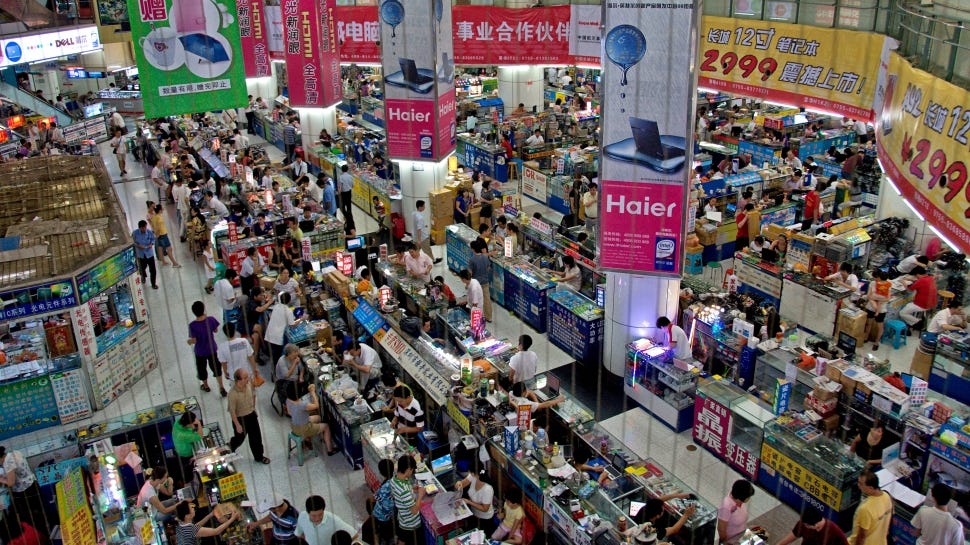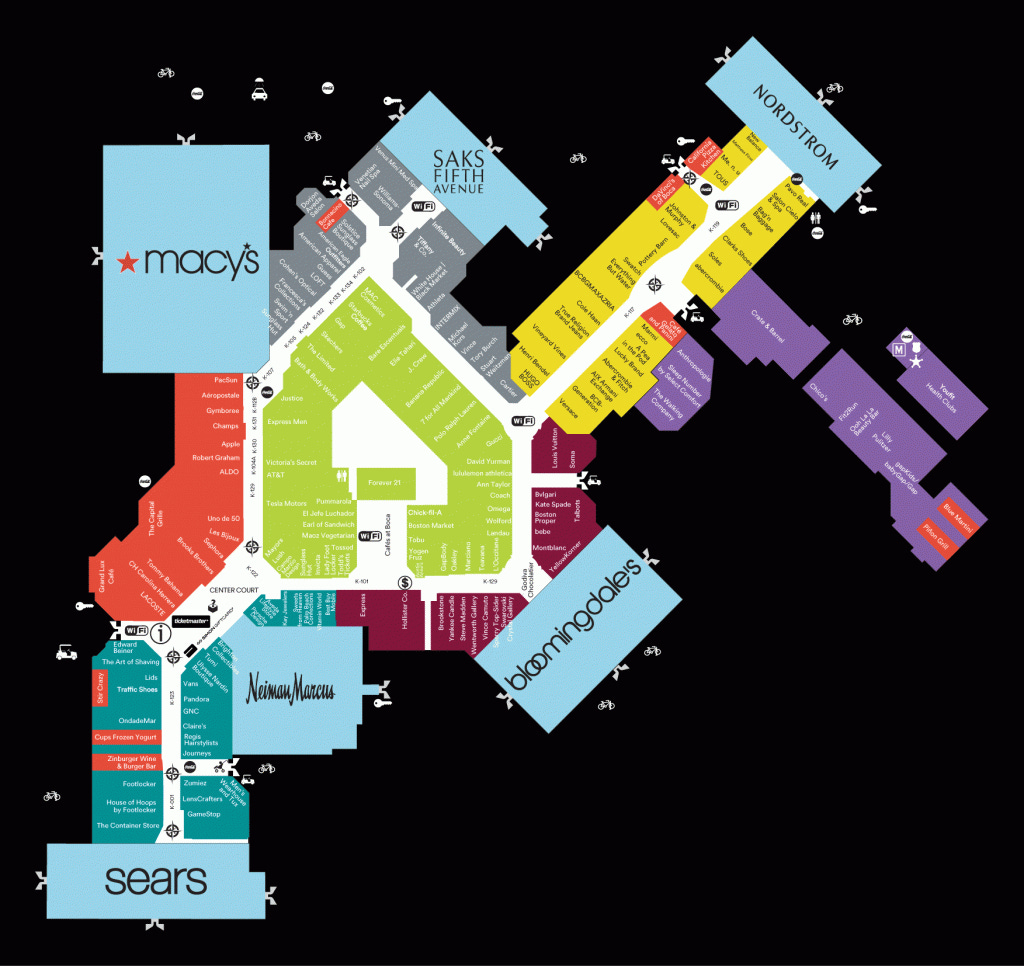Industrial Gardening
Earlier today, I got into a Twitter conversation with a few Twitter mutuals about what to do with America’s dying malls.
My suggestion was to, of course, turn them into something similar to Shenzhen’s famous electronics markets, though perhaps focused on other industries too. Though perhaps “similar to X” is probably not the best way of describing what I have in mind. This brief article is meant to go into a little more depth than what I can reasonably get across in a couple of 280-character tweets.
I really like the late Christopher Alexander’s concept of “life” in architecture, as it highlights the purpose of why we build. The purpose of architecture is to create a space that maximizes the number of interesting interactions that can happen within it.
A good example, which I’m taking from this great introduction to Alexander’s work, is that of a simple planter that you might find along a city street.
If the ledge around the plant is thin, there is very little human interaction that can occur, aside from perhaps admiring the plants or as a risky place to try to balance your drink. However, if the ledge on the planter is much wider, it allows people to sit, perhaps multiple people to sit, relax, set down their drinks, have a conversation.
Perhaps you’re outside and need to take a phonecall, or arranged to meet a friend. A planter with a wide ledge creates niches in the environment where such activities can happen, whereas an environment full of planters with very narrow ledges may force your activities elsewhere to find a more suitable location.
Lassez-faire free markets are the hunter-gatherer approach to industry; just letting businesses grow wherever they naturally do. However, far greater biological productivity is possible with a little more careful and focused effort.
I’m certainly not calling for a planned economy, but rather suggesting a more intentional approach to building the environment in which the economy exists. Creating a better environment for industry to flourish rather than planning innovation. Just because you plant a seed doesn’t mean it will grow as well as you hope. You shouldn’t count your eggs before they hatch. Nevertheless, there are deliberate actions you can take to make healthy crops and healthy hatchlings more common.
It seems that in America’s adversarial relationship with Communism, we’ve pushed ourselves too far in the opposite direction, making the idea of even a healthy approach to industrial gardening unthinkable, and so we don’t think to do it. People look at Shenzhen’s vast electronics markets in awe, but lament that “this could never happen in America”.
A little imagination and some suggestions of what could exist can go a long way.
The New American Industrial Gardens
Okay, let’s sketch out a basic outline of what this might look like.
First off, it doesn’t need to be electronics. America already has many cities with large, local scenes for specific industries. Madison, WI has a lot of biotech. Miami has a lot of crypto. San Francisco is of course Silicon Valley. Detroit has its auto industry (or at least what remains of it). Even in these cities there are often several smaller communities of startups in different fields as well. Madison also has a few crypto companies. What if these cities had a local hub where local businesses could meet?
As great as some large, notable cities might be for meeting people in your field, the highly disorganized and uncoordinated nature of what exists now also makes it very easy to miss people. I have friends who run crypto startups in Madison, and I recall a time where they were talking about another crypto startup they had recently learned about - a moderately successful startup that had been in the same city for several years that they had simply never heard of.
America’s dying malls already seem perfectly designed for becoming such a hub. After all, they were designed as a hub for general commerce and social activity; pushing them in similar, but slightly more industrial direction would not be that hard.
The core idea I have here is that we need to not just create a space that allows for a large volume of rich interactions between customers and businesses, but also between businesses themselves.
In particular, I’d highlight the need for markets, a social space, and eduction/recruiting, though by design there will be an enormous overlap between these three things.
Markets
The malls, now Industrial Gardens, stay open to the public. In fact, the public is strongly encouraged to visit, and there is a great deal of area dedicated to retail and b2c commerce.
One thing that should change in the transition from malls to Industrial Gardens is the move away from larger stores, and toward a larger number of smaller booths.
Sure, large stores, even a few thousand square feet should still be available, but the primary goal is to minimize the amount of effort for a business to have a presence in the space. That business could be anywhere between a small startup founded yesterday by a single person and a large company located on the other side of the country.
The entryway into the mall can be filled with retail businesses and booths from b2c startups. Keep the food courts for obvious reasons. Keep the tables, give people a public space to meet and have a conversation. “Hey, I overheard your conversation from my table over there and thought it was really interesting, can I join in?” should be heard regularly.
Opening a booth for your business should be dirt-cheap, even if the booth is just 20 square feet and little more than a table, a chair, and some signs about what you do. This means it’s not just cheap for the smallest of companies to have a presence, but to minimize the cost of a company keeping a presence in the space in the form of a part-time representative or two with a stand.
For reference, my mother buys and sells antiques and crafts as a side gig, and there are several local antique shops designed around letting people rent booths they can use to sell their own stuff. Despite being in a city of only ~30,000 people, there are multiple stores offering this, each with dozens of booths. This is something that works.
The antiques industry is already ahead of the tech industry here.
Of course, these booths at these antique/craft shops are largely not occupied most of the time, with the owners only stopping occasionally to collect their sales income, as well as to rearrange, redecorate, and restock. Our goal is to not just create a space for the exchange of goods and services, but for the exchange of ideas and opportunities as well.
Deeper into the Garden
Deeper into the Industrial Garden, down the hall from the food court and B2C booths, is the engine that drives this ecosystem. The B2B division.
If you’re someone interested in the deep technical details, this is where you will find technical people, coworking spaces, and booths from companies all across your supply chain.
The larger this garden grows, the more maintaining a presence in it makes sense for companies not just central to the industry, but in the periphery as well. After all, it’s dirt cheap. Over time companies from deeper and deeper in the supply chain start showing up. And you better believe that VCs and Angel investors can be found walking around.
New business niches even open up. Maybe many different companies, upon having frequent conversations with each other, find they have a common problem. It might make sense for a local startup that’s still trying to find its niche to come along and work with them to solve such a problem, instantly gaining multiple customers. Advertising today is already heavily biased toward consumes over businesses; creating a space where information can travel quickly between businesses can reveal many new opportunities. After all, arbitrage is fundamentally an information problem.
Booths from small businesses are everywhere. Former retail stores with a few thousand square feet are now coworking spaces, and offices and labs available for rent. Many local-to-medium-size companies operate out of here entirely.
Coffee shops, another food court, more space to talk and exchange ideas. A few whiteboards thrown in the mix. One or two of the former retail stores are meeting rooms and small event venues with projectors, whiteboards, perhaps even a podcast studio. Anyone who wants to can reserve an available time slot.
Have a hard technical problem you need help solving? Missing some parts in the device you’re building? Just got an urge to talk about some interesting new idea that’s been on your mind? There’s a huge community of people here you can turn to for help.
The old Sears becomes a huge hub, like a year-round expo hall. A corner or two of it is now a business offering small-scale manufacturing and same-day-prototyping. Someone can hear about a customer or business’s problem in the food court, draw up a CAD design, take it to the prototyping lab, and have it available for sale in a booth by the end of the day.
Perhaps though you’re not looking to start something, but are rather looking for a different way to get involved.
Detroit schools once taught their students not just reading, writing, and arithmetic, but also how a car engine works. In Motor City, it simply makes more sense to do this than not to.
The deeper parts of the Industrial Garden are not merely for the experts and workers, but for anyone who wants to dive in. On evenings and weekends, after the public gets off work, some of the meeting halls offer classes, open to the public to teach technical concepts and available for companies to seek out and recruit new, emerging talent.
Finally, it’s worth remembering that this isn’t just for software or hardware. Similar approaches could be taken for Agtech, Biotech, advanced manufacturing, and a wide variety of other industries. Perhaps industry-specific adaptations might be needed; maybe the agtech Industrial Garden needs a few greenhouses, chicken coops, cattle stalls, and a biology lab. Maybe a manufacturing Industrial Garden needs a makerspace with CNC machines, 3D printers, and other equipment.
Maybe some Industrial Gardens can be a hybrid between several industries; there’s a lot of interest in bringing robotics into agriculture, why not accelerate that? Many of these old malls would certainly be big enough for it, and even are designed as several independent wings branching off a central hub; one wing for retail, each additional wing dedicated to a particular industry, and the hub in the center where everyone can meet together.
Nevertheless, we really should do something with these malls other than just tear them down. And as someone living in the Rust Belt, I can assure you there is a great desire here for something to revive Amercian Industry. We just need to figure out how to plant the right seeds and let it grow.
Thank you for reading this Bzogramming article. I like to explore a lot of rather unusual ideas here around software engineering and development tooling, though occasionally I post stuff like this too.
If you want to suport this effort and see where I take the ideas in this article, I’d recommend sharing and subscribing.





